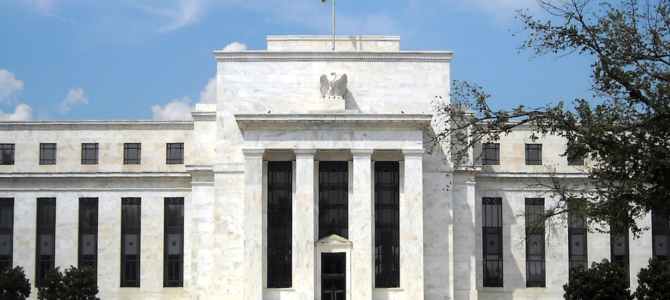
The recent debate over the proposed addition to the Federal Reserve Building, officially known as the Eccles Building, in Washington, D.C., exposes what could be an embarrassment for American society: Our official architecture flies against scientific logic. Continuing nonchalantly in this business-as-usual vein not only continues to create inhuman environments but also negates our glorious scientific advances.
Under debate is a proposal to add an incongruous glass box to the original marble-faced structure. This would be wrong for several reasons. Two essential points were surprisingly not mentioned so far in meetings of the Commission of Fine Arts, which is one of two bodies responsible for overseeing the project:
- A plain glass curtain wall is not perceived by human beings. People act as if such a façade is not there.
- Monotonous repetition as employed in a striped glass façade with vertical metal pillars generates mental stress that leads to headaches.
These findings are known to environmental psychologists and the medical world. The only people who willfully ignore them are architects, plus those who continue lobbying for industrial-modernist-style buildings.
Yet this is not a matter of aesthetics but of the mathematical ordering of our world. Never mind ordinary citizens’ complaints that our cities present a hostile psychological environment, nor the multiple issues with the energy and sustainability of such buildings. A deeply entrenched establishment controls the narrative about important new public buildings and has so far maintained its iron grip on the nation’s mind.
Politicians who have to make decisions based on expert advice are in a quandary. How do you decide on something like this when the chairs and deans of the most prestigious schools of architecture tell you it’s OK, yet a small group of researchers says it’s all wrong? Do you go with the consensus and the accepted method according to tradition — referring not to traditional architecture, but following the inertia of architectural decisions for the past several decades — which privileges the industrial-modernist style?
As our nation depends upon plurality opinion that forms the basis of representative democracy, decision-makers are unfortunately reluctant to pay too much attention to a small, dissenting group. Nevertheless, let me emphasize that dominant architectural taste has for decades reflected precisely the opinion of a tiny elite group out of touch with the majority.
Cult Apologists Propagate Architecture Myths
People who believe that sticking a sterile glass box onto the side of viscerally attractive architecture is an improvement instead of an affront don’t see any problem here. In the private sector, so long as clients continue to buy into the mythology of modernism, everything is just fine. Their business model relies on an architectural dogma that has been around since before the 1920s. So we have witnessed the unstoppable proliferation of inhuman façades that degrade the living qualities of our cities.
Intelligent people should keep up with scientific literacy and not adhere to practices that negatively affect the public. Some misleading architectural-political slogans were used to justify the types of buildings that emerged after World War II, but readers should beware of their dangerous, insidious propaganda. It’s important to note:
- Glass curtain walls do not represent political freedom — people are not liberated by visual transparency in a building.
- Glass curtain walls express visual transparency that has nothing to do with transparency in the activities that go on inside the building.
- Glass curtain walls are not a moral obligation of our times, and using other building materials poses no threat to economic progress.
Knowing the roots of mistaken beliefs is an important step in correcting them. The German glass industry hired architect Bruno Taut to build the “Glass Pavilion” for the 1914 Deutscher Werkbund Exhibition in Cologne, paying the construction costs. It also contracted fantasy-novelist Paul Scheerbart to write marketing copy eulogizing glass as a new building material, attributing to it semi-magical properties. The exhibition building was merely a setting, a publicity stunt, to display the advertising text. Those poetic slogans later assumed evangelical messianic qualities, and unwitting architecture students have had to learn them ever since.
Let’s forget nonsensical slogans praising glass as the uniquely privileged building material for our time. That they have been endlessly repeated as a religious text for several generations, however, makes them difficult to discard.
Many people presented with supposedly absolute, inviolate truths would rather die than renounce what they naively internalized as articles of faith. Belief in industrial-modernist design takes on the role of a substitute religion, which explains the odd association between inhuman designs and morality. For those who bought into this myth, admitting fault is simply too jarring and painful for the body and the ego.
Portugal Is a Poor Example
Last year, I was invited to Lisbon for a conference. One of the organized events was an on-site talk by the architect of the new extension to the historic Palace of Ajuda, construction on which began in 1794 but was never entirely finished. When I saw the slides accompanying the presentation, I got up to leave and was followed out by the puzzled conference organizer. I asked her to call a taxi because I needed to go visit a nearby historic church to recover from the shock.
The reason for my reaction is that the reconstruction adds an industrial-modernist façade (not glass) along one entire side, to include a new museum built in the style of a Soviet-era factory cafeteria. The architect expressed that “in this new project, admittedly contemporary, there is an analogy with the existing construction, not mimetic, according to the letters and conventions of restoration and rehabilitation.” The project adheres to the now-discredited 1933 Athens Charter, which forcibly imposed industrial modernism on all restoration projects.
But the new design reveals no analogy at all with the existing construction. An industrial-modernist 1920s-type façade negates any compositional relationship by refusing geometrical coherence and harmony with the existing historic structure. Furthermore, saying the design conforms with accepted conventions of restoration and rehabilitation ignores the change in historic preservation that has occurred in the past few years.
Why should we care about a Portuguese national heritage site that’s going to be drastically altered by the addition of an incongruous façade sporting a “contemporary” look? If the Portuguese people are ready to implement it, surely that doesn’t concern us. It’s too far away for us to be worried about it.
On the contrary, this is relevant to the present architectural discussion because we are about to commit exactly the same mistake with the Federal Reserve Building.
This Has Nothing to Do with Style
The press has so far presented the debate as pitting old-fashioned classical architects against forward-looking modernist architects. This facile interpretation is wrong and misleading.
Neo-classical architects have good reasons to dislike glass boxes, which are the antithesis of their finely detailed designs that focus on materiality. But if we look beneath the surface rhetoric, we will realize that glass boxes express discredited ideas from the 1920s and ought to have limited place in modern society.
How about the even older classical buildings? Those older typologies evolved to accommodate human psychological and physiological responses, and are therefore just as relevant today as ever. We can adapt a classical design to today’s needs, but a glass box will always be a glass box.
As a group of colleagues and I have argued for decades, we know how to build wonderful new buildings today. You just have to ask the right architect who knows how to do it, and keep away from those who stick with cult images. It’s time for our society to awaken from its media-induced slumber and demand human-scale architecture once again.
Since we take pride in American intellectual dominance because of our scientific advances, let us rely on them to decide architecture’s future. Let’s welcome American ingenuity and creativity to show us how to create healing environments. Let’s implement true science — not technology commandeered by vested interests to continue the ubiquitous 1920s industrial-modernist typologies — to improve our health, society, and wellbeing.









